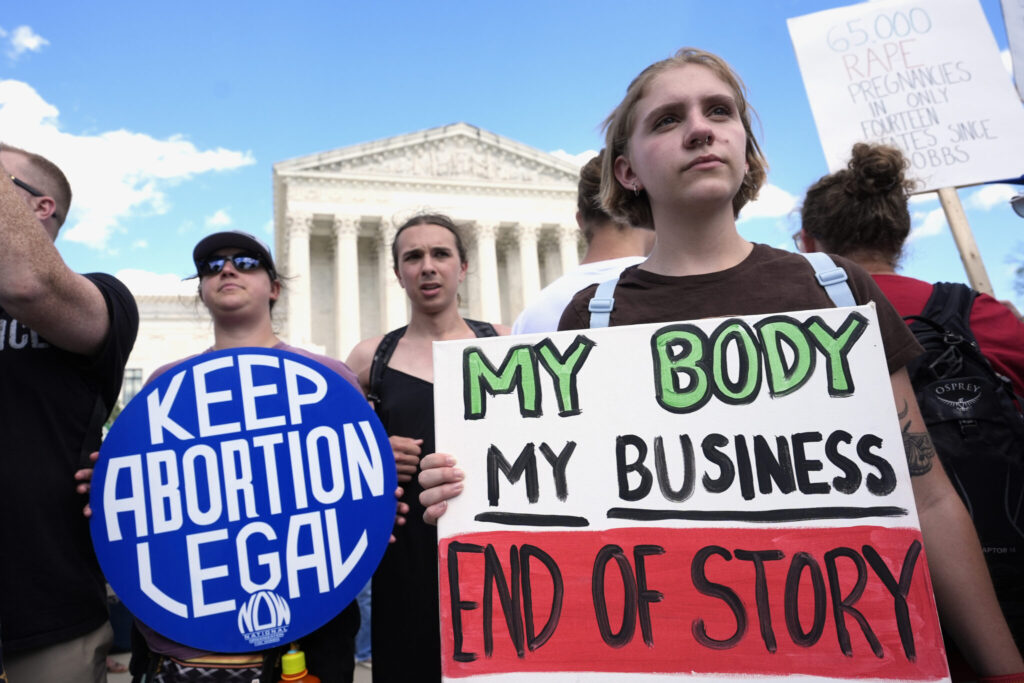Abortion was more common across the U.S. in the first three months of this year than it was before the Supreme Court overturned Roe v. Wade and cleared the way for states to implement bans, a report released Wednesday found. A major reason for the increase is that some Democratic-controlled states enacted laws to protect doctors who use telemedicine to see patients in places that have abortion bans, according to the quarterly #WeCount report for the Society of Family Planning, which supports abortion access.
Quick Read
- US abortion numbers have risen slightly since Roe was overturned, study finds:
- Increased Abortion Numbers: Abortion was more common across the U.S. in the first three months of 2024 compared to before the Supreme Court overturned Roe v. Wade.
- Telemedicine’s Role: The increase is partly due to some Democratic-controlled states enacting laws to protect doctors who use telemedicine to prescribe abortion pills to patients in states with abortion bans.
- Impact of State Bans: The number of abortions fell to nearly zero in states that ban abortion at all stages of pregnancy and declined by about half in places that ban it after six weeks of pregnancy.
- Increase in Legal States: Numbers went up in places where abortion remains legal, especially in states like Illinois, Kansas, and New Mexico, which border states with bans.
- Abortion Pills and Telemedicine: In March, nearly 10,000 patients in states with bans or restrictions received abortion pills prescribed via telemedicine from doctors in states with protective laws.
- Effectiveness of Shield Laws: Laws protecting medical providers who use telemedicine for prescribing abortion pills started taking effect in some Democratic-led states last year, easing the burden on clinics.
- Supreme Court Ruling Impact: The Supreme Court’s June 2022 ruling in Dobbs v. Jackson Women’s Health Organization has significantly changed how abortion is accessed and provided in the U.S.
- Florida’s Abortion Numbers: Florida saw an increase in abortions, but a new six-week ban effective in April could change this. There is a November ballot measure that could make abortion legal until viability.
- Abortion-Related Measures: Abortion-related measures are on the ballot in six states, with more possibly pending in four others, including dueling amendments in Nebraska.
- Public Opinion and Voting: Public opinion polls show growing support for abortion rights, and recent ballot measures have all favored abortion-rights supporters. Arizona may have a ballot measure expanding access to 24 weeks.
- Impact on Elections: In Missouri, where nearly all abortions are banned, a proposed constitutional amendment guaranteeing abortion rights could impact voter turnout and competitive legislative races.
The Associated Press has the story:
US abortion numbers have risen since Roe was overturned, study finds
Newslooks- (AP)
Abortion was more common across the U.S. in the first three months of this year than it was before the Supreme Court overturned Roe v. Wade and cleared the way for states to implement bans, a report released Wednesday found. A major reason for the increase is that some Democratic-controlled states enacted laws to protect doctors who use telemedicine to see patients in places that have abortion bans, according to the quarterly #WeCount report for the Society of Family Planning, which supports abortion access.
The data comes ahead of November elections in which abortion-rights supporters hope the issue will drive voters to the polls. In some places, voters will have a chance to enshrine or reject state-level abortion protections. Fallout from the Supreme Court’s June 2022 ruling in Dobbs v. Jackson Women’s Health Organization has remade the way abortion works across the country. The #WeCount data, which has been collected in a monthly survey since April 2022, shows how those providing and seeking abortion have adapted to changing laws.

The survey found that the number of abortions fell to nearly zero in states that ban abortion in all stages of pregnancy and declined by about half in places that ban it after six weeks of pregnancy, before many women know they are pregnant. Fourteen states are enforcing bans on abortion at all stages of pregnancy, with some exceptions, and four others bar it after about six weeks of pregnancy. Numbers went up in places where abortion remains legal until further into pregnancy — and especially in states such as Illinois, Kansas and New Mexico, which border states with bans.
Abortion pills and telemedicine play a key role. In March, doctors in states with laws to protect medical providers used telemedicine to prescribe abortion pills to nearly 10,000 patients in states with bans or restrictions on abortion by telehealth — accounting for about 1 in 10 abortions in the U.S. Laws to protect medical providers who use telemedicine to prescribe abortion pills started taking effect in some Democratic-led states last year. “It eases the burden on clinics,” said Ushma Upadhyay, a University of California, San Francisco School of Medicine professor who co-leads #WeCount. “So it creates more space for the people who are coming to clinics.”
Abortion opponents say the fight over the abortion drug mifepristone isn’t over after a narrow Supreme Court ruling that preserved access to it for now. But so far there have not been legal challenges to shield laws. The latest edition of the survey covers the first three months of this year. January was the first time since the survey began that it’s counted more than 100,000 abortions across the country in a single month. Before the shield laws began kicking in and #WeCount started tallying them, people were still getting some pills in places with bans.
Upadhyay said that even before the fall of Roe, abortion demand was greater than access. She also said that even with the changing patterns, some women are continuing pregnancies they would have ended if they could have. One of the states where abortions increased was Florida. That changed in April, when a ban after six weeks’ gestation took effect. The data doesn’t yet reflect that change.
The policy could change again through a November ballot measure that would make abortion legal until viability, generally considered to be around 23 or 24 weeks into pregnancy. It would take at least 60% approval to add that to the state constitution. One vote against it will come from Mia Adkins, a 20-year-old senior at Florida International University. She said the overturning of Roe and changes in Florida’s law have brought more attention to abortion and have strengthened her belief that there should be limits. “Instead of pushing for more abortion legal later in pregnancy, we should be pushing for laws that protect these pregnant parents and students and provide them with the support that they need,” said Akins, a senior at Florida International University.
Florida is one of six states where abortion-related measures are already on the ballot. Determinations from elections officials about adding similar questions are pending in four more states. In one, Nebraska, there are dueling amendments: One to allow access until viability and one to keep the current policy, which bans most abortions after 12 weeks of pregnancy. Abortion-rights supporters have prevailed in all seven abortion ballot questions in the U.S. since 2022. That tracks with public opinion polling that has shown growing support for abortion rights, including a recent Associated Press-NORC poll that found 6 in 10 Americans think their state should allow someone to obtain a legal abortion if they don’t want to be pregnant for any reason.
An amendment to protect access could be on the ballot in Arizona, a political battleground state where court cases have swung abortion policy — and access — since the Dobbs ruling. The state Supreme Court ruled in April that Arizona should enforce an 1864 ban on abortions at all stages of pregnancy, only for lawmakers to repeal that law. The state’s ban on abortion after 15 weeks of pregnancy remains. The ballot measure would expand it to 24 weeks. Natalie Harper, a 23-year-old independent who usually doesn’t vote, said the potential of bringing back the Civil War-era ban “absolutely” impacts her decision to head to the polls and support the ballot measure this November. “Seeing that as a possibility really made me realize that everyone’s pro-choice voices need to be heard in hopes it never goes in that direction again,” she said.
In Missouri, which has outlawed almost all abortions and where nearly none were reported in the new data, election officials could soon certify whether a proposed constitutional amendment guaranteeing abortion rights received enough petition signatures to qualify for the ballot in the reliably Republican state. University of Missouri political scientist Peverill Squire said that if the measure is put before voters, it could draw out enough Democratic voters to help swing a few competitive legislative races. “They can seize on the personal freedom arguments the Republicans have generally owned over the recent elections,” he said.







